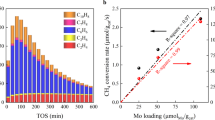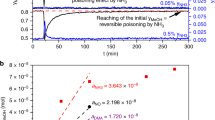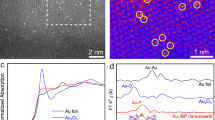Abstract
The oxidation of methane, the main component of natural gas, to selectively form oxygenated chemical feedstocks using molecular oxygen has been a long-standing grand challenge in catalysis. Here, using gold nanoparticles supported on the zeolite ZSM-5, we introduce a method to oxidize methane to methanol and acetic acid in water at temperatures between 120 and 240 °C using molecular oxygen in the absence of any added coreductant. Electron microscopy reveals that the catalyst does not contain gold atoms or clusters, but rather gold nanoparticles are the active component, while a mechanism involving surface adsorbed species is proposed in which methanol and acetic acid are formed via parallel pathways.

This is a preview of subscription content, access via your institution
Access options
Access Nature and 54 other Nature Portfolio journals
Get Nature+, our best-value online-access subscription
$29.99 / 30 days
cancel any time
Subscribe to this journal
Receive 12 digital issues and online access to articles
$119.00 per year
only $9.92 per issue
Buy this article
- Purchase on Springer Link
- Instant access to full article PDF
Prices may be subject to local taxes which are calculated during checkout






Similar content being viewed by others
Data availability
All data used in this publication are available free of charge from Cardiff University via https://doi.org/10.17035/d.2021.0142278187 or available from the authors upon reasonable request. Source data are provided with this paper.
References
Hammer, G. et al. Natural Gas in Ullmann’s Encyclopaedia of Industrial Chemistry (Wiley-VCH, 2012).
Gesser, H. D., Hunter, N. R. & Prakash, C. B. The direct conversion of methane to methanol by controlled oxidation. Chem. Rev. 85, 235–244 (1985).
Conley, B. L. et al. Design and study of homogenous catalysts for the selective, low temperature oxidation of hydrocarbons. J. Mol. Cat. A Chem. 251, 8–23 (2006).
Hargreaves, J. S. J., Hutchings, G. J. & Joyner, R. W. Control of product selectivity in the partial oxidation of methane. Nature 348, 428–429 (1990).
Periana, R. A. et al. A mercury-catalyzed, high-yield system for the oxidation of methane to methanol. Science 259, 340–343 (1993).
Periana, R. A. et al. Platinum catalysts for the high-yield oxidation of methane to a methanol derivative. Science 280, 560–564 (1998).
Sobolev, V. I., Dubkov, K. A., Panna, O. V. & Panov, G. I. Selective oxidation of methane to methanol on a FeZSM-5 surface. Catal. Today 24, 251–252 (1995).
Starokon, E. V. et al. Oxidation of methane to methanol on the surface of FeZSM-5 zeolite. J. Catal. 300, 47–54 (2013).
Starokon, E. V., Parfenov, M. V., Pirutko, L. V., Abornev, S. I. & Panov, G. I. Room-temperature oxidation of methane by α-oxygen and extraction of products from the FeZSM-5 surface. J. Phys. Chem. C 115, 2155–2161 (2011).
Parfenov, M. V., Starokon, E. V., Pirutko, L. V. & Panov, G. I. Quasicatalytic and catalytic oxidation of methane to methanol by nitrous oxide over FeZSM-5 zeolite. J. Catal. 318, 14–21 (2014).
Hammond, C. et al. Direct catalytic conversion of methane to methanol in an aqueous medium by using copper-promoted Fe-ZSM-5. Angew. Chem. Int. Ed. 51, 5129–5133 (2012).
Yu, T. et al. Highly selective oxidation of methane into methanol over Cu-promoted monomeric Fe/ZSM-5. ACS Catal. 11, 6684–6691 (2021).
Narsimhan, K. et al. Methane to acetic acid over Cu-exchanged zeolites: mechanistic insights from a site-specific carbonylation reaction. J. Am. Chem. Soc. 137, 1825–1832 (2015).
Shan, J., Li, M., Allard, L. F., Lee, S. & Flytzani-Stephanopoulos, M. Mild oxidation of methane to methanol or acetic acid on supported isolated rhodium catalysts. Nature 551, 605–608 (2017).
Tang, Y. et al. Single rhodium atoms anchored in micropores for efficient transformation of methane under mild conditions. Nat. Commun. 9, 1231 (2018).
Jin, Z. et al. Hydrophobic zeolite modification for in situ peroxide formation in methane oxidation to methanol. Science 367, 193–197 (2020).
Agarwal, N. et al. Aqueous Au-Pd colloids catalyze selective CH4 oxidation to CH3OH with O2 under mild conditions. Science 358, 223–226 (2017).
Groothaert, M. H., Smeets, P. J., Sels, B. F., Jacobs, P. A. & Schoonheydt, R. A. Selective oxidation of methane by the bis(μ-oxo)dicopper core stabilized on ZSM-5 and mordenite zeolites. J. Am. Chem. Soc. 127, 1394–1395 (2005).
Patrick, T. et al. Isothermal cyclic conversion of methane into methanol over copper-exchanged zeolite at low temperature. Angew. Chem. Int. Ed. 55, 5467–5471 (2016).
Grundner, S. et al. Single-site trinuclear copper oxygen clusters in mordenite for selective conversion of methane to methanol. Nat. Commun. 6, 7546 (2015).
Sushkevich, V. L., Palagin, D., Ranocchiari, M. & van Bokhoven, J. A. Selective anaerobic oxidation of methane enables direct synthesis of methanol. Science 356, 523–527 (2017).
Narsimhan, K., Iyoki, K., Dinh, K. & Román-Leshkov, Y. Catalytic oxidation of methane into methanol over copper-exchanged zeolites with oxygen at low temperature. ACS Cent. Sci. 2, 424–429 (2016).
Dinh, K. T. et al. Continuous partial oxidation of methane to methanol catalyzed by diffusion-paired copper dimers in copper-exchanged zeolites. J. Am. Chem. Soc. 141, 11641–11650 (2019).
Koishybay, A. & Shantz, D. F. Water is the oxygen source for methanol produced in partial oxidation of methane in a flow reactor over Cu-SSZ-13. J. Am. Chem. Soc. 142, 11962–11966 (2020).
Sarv, P. et al. Mobility of the acidic proton in Brønsted sites of H-Y, H-mordenite, and H-ZSM-5 zeolites, studied by high-temperature 1H MAS NMR. J. Phys. Chem. 99, 13763–13768 (1995).
Herzing, A. A., Kiely, C. J., Carley, A. F., Landon, P. & Hutchings, G. J. Identification of active gold nanoclusters on iron oxide supports for CO oxidation. Science 321, 1331–1335 (2008).
He, Q. et al. Population and hierarchy of active species in gold iron oxide catalysts for carbon monoxide oxidation. Nat. Commun. 7, 12905 (2016).
Jin, R. et al. Low temperature oxidation of ethane to oxygenates by oxygen over iridium-cluster catalysts. J. Am. Chem. Soc. 141, 18921–18925 (2019).
Gouget, A. et al. Increased dispersion of supported gold during methanol carbonylation. J. Am. Chem. Soc. 131, 6973–6975 (2009).
Denisov, E. T. & Shestakov, A. F. Reactions of alkoxy and peroxy radicals with carbon monoxide. Kinet. Catal. 49, 1–10 (2008).
Boronat, M., Concepción, P. & Corma, A. Unravelling the nature of gold surface sites by combining IR spectroscopy and DFT calculations. Implications in catalysis. J. Phys. Chem. C 113, 16772–16784 (2009).
Liu, Z.-P., Hu, P. & Alavi, A. Catalytic role of gold in gold-based catalysts: a density functional theory study on the CO oxidation on gold. J. Am. Chem. Soc. 124, 14770–14779 (2002).
Cooper, C. M. & Wiezevich, P. J. Effects of temperature and pressure on the upper explosive limit of methane-oxygen mixtures. Ind. Eng. Chem. 21, 1210–1214 (1929).
Liu, M. et al. Improved WATERGATE pulse sequences for solvent suppression in NMR spectroscopy. J. Magn. Reson. 132, 125–129 (1998).
Sarradin, P.-M. & Caprais, J.-C. Analysis of dissolved gases by headspace sampling gas chromatography with column and detector switching. Preliminary results. Anal. Commun. 33, 371–373 (1996).
Kresse, G. & Hafner, J. Ab initio molecular dynamics for liquid metals. Phys. Rev. B 47, 558–561 (1993).
Kresse, G. & Furthmüller, J. Efficient iterative schemes for ab initio total-energy calculations using a plane-wave basis set. Phys. Rev. B 54, 11169–11186 (1996).
Perdew, J. P., Burke, K. & Ernzerhof, M. Generalized gradient approximation made simple. Phys. Rev. Lett. 77, 3865–3868 (1996).
Grimme, S., Antony, J., Ehrlich, S. & Krieg, H. A consistent and accurate ab initio parametrization of density functional dispersion correction (DFT-D) for the 94 elements H-Pu. J. Chem. Phys. 132, 154104 (2010).
Kresse, G. & Joubert, D. From ultrasoft pseudopotentials to the projector augmented-wave method. Phys. Rev. B 59, 1758–1775 (1999).
Blöchl, P. E. Projector augmented-wave method. Phys. Rev. B 50, 17953–17979 (1994).
Mills, G., Jónsson, H. & Schenter, G. K. Reversible work transition state theory: application to dissociative adsorption of hydrogen. Surf. Sci. 324, 305–337 (1995).
Hjorth Larsen, A. et al. The atomic simulation environment—a Python library for working with atoms. J. Phys. Condens. Matter 29, 273002 (2017).
Henkelman, G. & Jónsson, H. A dimer method for finding saddle points on high dimensional potential surfaces using only first derivatives. J. Chem. Phys. 111, 7010–7022 (1999).
Kästner, J. & Sherwood, P. Superlinearly converging dimer method for transition state search. J. Chem. Phys. 128, 014106 (2008).
Thetford, A., Hutchings, G. J., Taylor, S. H. & Willock, D. J. The decomposition of H2O2 over the components of Au/TiO2 catalysts. Proc. R. Soc. Math. Phys. Eng. Sci. 467, 1885–1899 (2011).
Acknowledgements
This work was financially supported by the National Natural Science Foundation of China (grants U1932218, 21872170, 21733013 and 22061130202), as part of the Key projects of international partnership plan for foreign cooperation programme (112942KYSB20180009). J.X. thanks the Royal Society and the Newton Fund for Royal Society—Newton Advanced Fellowship. G.J.H. acknowledges the support from the Chinese Academy of Sciences President’s International Fellowship Initiative (grant no. 2019DM0015). Q.H. thanks the National Research Foundation Singapore for support under its NRF Fellowship (NRF-NRFF11-2019-0002). We thank Cardiff University and the Max Planck Centre for Fundamental Heterogeneous Catalysis (FUNCAT) for financial support. G.J.H., D.J.W. and C.R.A.C. thank the Engineering and Physical Sciences Research Council for funding this work (grant reference codes EP/P033695/1 and EP/L027240/1). Via our membership of the United Kingdom’s HEC Materials Chemistry Consortium, which is funded by the Engineering and Physical Sciences Research Council (EP/L000202 and EP/R029431), this work used the ARCHER UK National Supercomputing Service (http://www.archer.ac.uk) and the UK Materials and Molecular Modelling Hub, which is partially funded by the Engineering and Physical Sciences Research Council (EP/P020194), for computational resources.
Author information
Authors and Affiliations
Contributions
J.X. and G.J.H. conceived the research idea and organized the research programmes. G.Q. and R.J.L. prepared catalyst samples; G.Q., X.Z. and F.D. performed the catalytic experiments and NMR analysis; T.E.D., Q.H. and A.G.R.H. obtained electron microscopy data under the direction of C.J.K.; D.J.W., A.N., M.A.S. and M.Q. carried out most of the computational chemistry calculations. D.B. and M.J.H. provided mechanistic interpretation of results along with C.R.A.C. and D.J.W., who integrated experimental and computational insights. B.A.M. and B.H. provided advice on the industrial context of the work. J.X., G.J.H. and D.J.W. wrote the paper, and all authors discussed the results and the various revisions of the manuscript. J.X. and G.J.H. contributed equally to this work.
Corresponding authors
Ethics declarations
Competing interests
The authors declare no competing interests.
Peer review information
Nature Catalysis thanks the anonymous reviewers for their contribution to the peer review of this work.
Additional information
Publisher’s note Springer Nature remains neutral with regard to jurisdictional claims in published maps and institutional affiliations.
Supplementary information
Supplementary Information
Supplementary Figs. 1–25, Tables 1–15, Notes 1 and 2 and references.
Source data
Source Data Fig. 1
Statistical source data.
Source Data Fig. 2
Statistical source data.
Source Data Fig. 5
Statistical source data.
Rights and permissions
About this article
Cite this article
Qi, G., Davies, T.E., Nasrallah, A. et al. Au-ZSM-5 catalyses the selective oxidation of CH4 to CH3OH and CH3COOH using O2. Nat Catal 5, 45–54 (2022). https://doi.org/10.1038/s41929-021-00725-8
Received:
Accepted:
Published:
Issue Date:
DOI: https://doi.org/10.1038/s41929-021-00725-8



